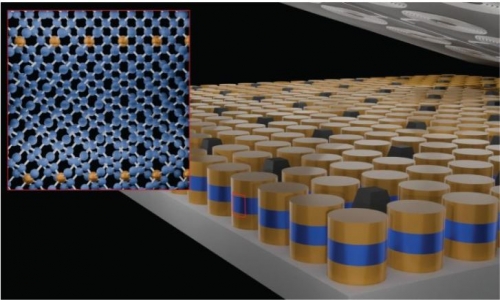


 1:9:50
1:9:50  2025-03-16
2025-03-16  759
759

Smarter, Faster, and More Efficient Signal Boosting
A new optical amplifier is changing the game. Unlike conventional amplifiers, this chip-based breakthrough leverages optical nonlinearity rather than rare-earth elements, allowing signals to strengthen themselves. The result? A compact, high-performance device with a bandwidth three times wider than traditional solutions.
Expanding the Limits of Optical Amplification
Modern communication networks rely on optical signals to transmit massive amounts of data. However, like weak radio signals, these optical signals need amplification to travel long distances without degrading. For decades, erbium-doped fiber amplifiers (EDFAs) have been the standard solution, extending transmission range without requiring frequent signal regeneration. Despite their effectiveness, EDFAs operate within a limited spectral range, restricting the growth of optical networks.
With the demand for high-speed data transmission increasing – driven by AI accelerators, data centers, and high-performance computing – existing optical amplifiers are showing their limitations. Researchers are now exploring ways to develop more powerful, flexible, and compact amplifiers to keep up with rising data needs.
The need for ultra-broadband amplification, which enables signal boosting across a wider range of wavelengths, has never been greater. While alternatives like Raman amplifiers offer some improvements, they remain complex and energy-intensive, highlighting the urgency for more efficient solutions.
A Breakthrough in Chip-Based Amplification
Now, researchers led by Tobias Kippenberg at EPFL and Paul Seidler at IBM Research Europe – Zurich have developed a photonic-chip-based traveling-wave parametric amplifier (TWPA) that achieves ultra-broadband signal amplification in an unprecedentedly compact form. Using gallium phosphide-on-silicon dioxide technology, the new amplifier attains a net gain of over 10 dB across a bandwidth of approximately 140 nm — three times wider than a conventional C-band EDFA.
Most amplifiers rely on rare-earth elements to strengthen signals. Instead, the new amplifier uses optical nonlinearity — a property where light interacts with a material to amplify itself. By carefully designing a tiny spiral waveguide, the researchers created a space where light waves reinforce each other, boosting weak signals while keeping noise low. This method not only makes the amplifier more efficient but also allows it to work across a much broader range of wavelengths, all within a compact, chip-sized device.
The Power of Gallium Phosphide
The team chose gallium phosphide because of its exceptional optical properties. First, it exhibits strong optical nonlinearity, which means that light waves passing through it can interact in a way that boosts signal strength. Second, it has a high refractive index, which allows light to be confined tightly within the waveguide, leading to more efficient amplification.
By using gallium phosphide, the scientists achieved high gain with a waveguide only a few centimeters long, significantly reducing the amplifier’s footprint and making it practical for next-generation optical communication systems.
Exceptional Performance and Versatility
The researchers demonstrated that their chip-based amplifier could achieve up to 35 dB of gain while keeping the noise low. Additionally, remarkably weak signals could be amplified, with the amplifier handling input powers ranging over six orders of magnitude. These features make the new amplifier highly adaptable to a variety of applications beyond telecommunications, such as precision sensing
The amplifier also enhanced the performance of optical frequency combs and coherent communication signals — two key technologies in modern optical networks and photonics — showing that such photonic integrated circuits can surpass traditional fiber-based amplification systems.
A New Era for Optical Communication and Beyond
The new amplifier has far-reaching implications for the future of data centers, AI processors, and high-performance computing systems, all of which can benefit from faster, more efficient data transfer. And the applications extend beyond data transmission, to optical sensing, metrology, and even LiDAR systems used in self-driving vehicles.
Reality Of Islam |
|

Cameras hav

For years,

New scienti

This is the
 9:3:43
9:3:43
 2018-11-05
2018-11-05
10 benefits of Marriage in Islam
 7:5:22
7:5:22
 2019-04-08
2019-04-08
benefits of reciting surat yunus, hud &
 9:45:7
9:45:7
 2018-12-24
2018-12-24
advantages & disadvantages of divorce
 11:35:12
11:35:12
 2018-06-10
2018-06-10
 6:0:51
6:0:51
 2018-10-16
2018-10-16
 8:4:21
8:4:21
 2022-01-08
2022-01-08
 2:13:43
2:13:43
 2022-05-27
2022-05-27
 7:26:19
7:26:19
 2022-04-08
2022-04-08
 8:39:51
8:39:51
 2022-09-23
2022-09-23
 9:39:36
9:39:36
 2022-12-28
2022-12-28
 10:47:11
10:47:11
 2022-11-22
2022-11-22
 4:2:19
4:2:19
 2022-10-10
2022-10-10
 5:41:46
5:41:46
 2023-03-18
2023-03-18
| LATEST |